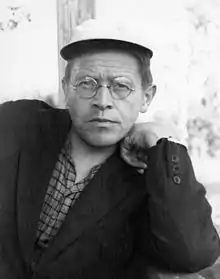Lauri Pihkala
Lauri "Tahko" Pihkala (born Gummerus, 5 January 1888 – 20 May 1981) was the inventor of pesäpallo, the Finnish variant of baseball.[2] In 1969 he became one of the first persons to receive an honorary doctorate in Sport Sciences from the University of Jyväskylä, together with president Urho Kekkonen and Professor Kaarina Kari.[3]
 | |
| Personal information | |
|---|---|
| Born | 5 January 1888 Pihtipudas, Finland |
| Died | 20 May 1981 (aged 93) Helsinki, Finland |
| Height | 179 cm (5 ft 10 in) |
| Weight | 79 kg (174 lb) |
| Sport | |
| Sport | Athletics |
| Event(s) | 800 m, high jump, discus throw |
| Club | HKV, Helsinki |
| Achievements and titles | |
| Personal best(s) | 800 m – 1:58.1 (1911) HJ – 1.75 m (1909) DT – 31.40 m (1906)[1] |

Athletics
| Games | Event | Rank | Results | Notes |
|---|---|---|---|---|
| 1908 Summer Olympics | High jump | 16th | 5 feet 6 inches (168 cm) | Height was measured in inches. Source:[4] |
| Discus throw | 12th–42nd | unknown | Source:[5] | |
| Shot put | Did not start | Source:[6] | ||
| 1912 Summer Olympics | 800 metres, heats | Did not finish | ||
In the 1910s he became the first Finnish professional coach in athletics, and also worked as a physical education instructor with the Finnish Army.[2]
Pihkala was known for being an avid sports fan, and he developed several outdoor games.
Other
During the Finnish Civil War he was responsible for propaganda in the White Guard flying unit "Devils of Kuhmoinen" of major Hans Kalm.
Pihkala's brother Martti Pihkala was a right-wing political activist. Lauri Pihkala didn't write any political texts in his publications. He tried to integrate Finnish working class to the society and hoped that sports could be one tool there.[7]
Some writers claim that Pihkala should be responsible for a massacre in Harmoinen village in March 1918. This is not true. The murderers belonged to Devils of Kuhmoinen, but Pihkala was not present there.[8]
Memorial of Pihkala by sculptor Nina Sailo was unveiled in 1988 on the south-east side of the Helsinki Olympic Stadium.[9]
References
- Lauri Pihkala. sports-reference.com
- Lauri Pihkala (1888-1981). Suomen urheilun Hall of Fame
- "Lauri Pihkala". Olympedia. Retrieved 12 March 2021.
- Mallon, Bill; Buchanan, Ian (2001). The 1908 Olympic Games: Results for All Competitors in All Events, With Commentary. Jefferson, North Carolina, United States: McFarland. p. 80. ISBN 978-0-7864-0598-5.
- Mallon, Bill; Buchanan, Ian (2001). The 1908 Olympic Games: Results for All Competitors in All Events, With Commentary. Jefferson, North Carolina, United States: McFarland. p. 92. ISBN 978-0-7864-0598-5.
- Mallon, Bill; Buchanan, Ian (2001). The 1908 Olympic Games: Results for All Competitors in All Events, With Commentary. Jefferson, North Carolina, United States: McFarland. p. 112, endnote 238. ISBN 978-0-7864-0598-5.
- Virtapohja, Kalle (2022). Lauri Pihkala : Koko kansan Tahko. Helsinki: Docendo. p. 84. ISBN 978-952-382-200-9.
- Virtapohja, pp. 89–93.
- "Lauri Tahko Pihkala". HAM. Helsinki Art Museum. Retrieved 17 March 2018.